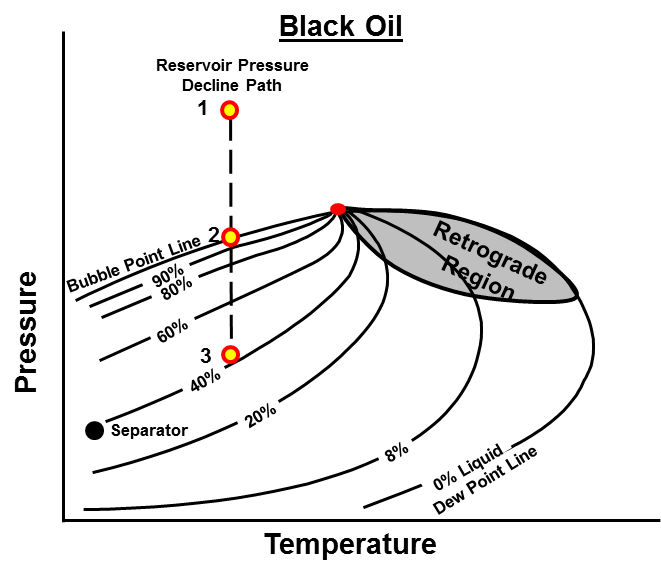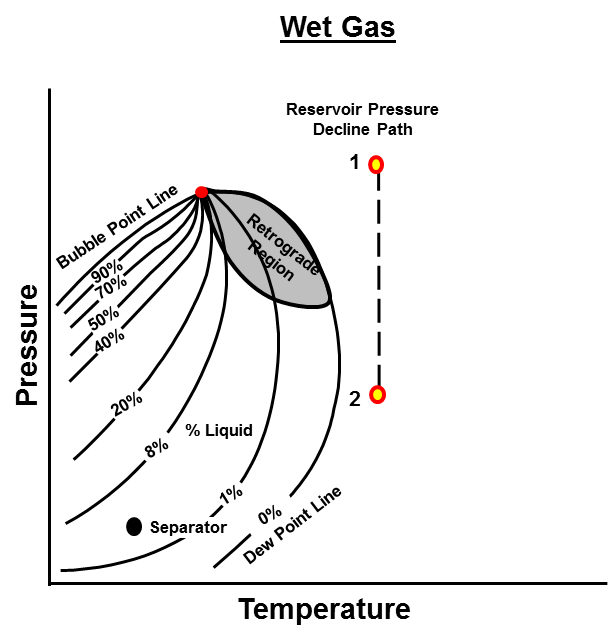The reservoir can produce different types of fluids. Each different fluid type has characteristics that petroleum engineers need to be aware of in order to produce the reservoir efficiently. Generally the reservoir fluid types are classified into 5 separate categories from a phase diagram. They are:
- Black Oil
- Volatile Oil
- Gas Condensate
- Wet Gas
- Dry Gas
The fluid type can be identified by the shape of it’s phase diagram and the position of it’s critical point relative to the reservoir temperature. In the following figures, we assume that the reservoir pressure declines at a constant temperature (isothermal condition).
Black Oil
The figure below shows the pressure decline of a black oil reservoir on a phase diagram. The vertical line from point 1 to point 3 represents the reservoir pressure decline path at a constant temperature. The pressure and temperature of a separator at the surface is also shown in the diagram.

For a black oil reservoir, the initial pressure at point 1 is much larger than the bubble point pressure. When reservoir pressure is above the bubble point (between point 1 and point 2), we call this the undersaturated reservoir state. Undersaturated implies that the oil can absorb more gas if more gas became present in the reservoir. When the pressure hits the bubble point line at point 2, the first bubble of gas forms. Below point 2, gas starts to evolve out of the oil into the reservoir. We call this the saturated reservoir state. Saturated implies that the oil cannot absorb more gas if more gas became present in the reservoir. As the pressure declines further to point 3, more gas evolves out of the oil into the reservoir. At point 3, the reservoir pressure can no longer push the fluids to the surface under it’s current state. At the surface separator condition, more gas evolves out of the oil. For black oil reservoirs, a large percentage of the oil phase is recovered at the surface .
Volatile Oil
The figure below show the pressure decline of a volatile oil reservoir on a phase diagram.

A volatile oil reservoir starts out like a black oil reservoir with the initial reservoir pressure lying above the bubble point line. However for a volatile oil, the initial pressure is much closer to the bubble point pressure. This is because a volatile oil reservoir contains more lighter hydrocarbon components than the black oil reservoir, thus the phase diagram shifts up and to the left. Further, the quality lines are closer together. This means that a small reduction of pressure below the bubble point line will release a large quantity of gas. For a volatile oil reservoir, more gas is produced at the surface because more solution gas evolves out of the oil. This lead to less liquid recovery as indicated in the phase diagram above. The dividing line between volatile oils and black oils are somewhat arbitrary. But it should be clear that volatile oils produce a higher quantity of gas than black oils.
Gas Condensate
The figure below shows the pressure decline of a gas condensate oil reservoir on a phase diagram:

A gas condensate reservoir is identified by its temperature. The reservoir temperature falls between the critical point temperature and the cricondentherm. As pressure declines below the dew point line, the heavier hydrocarbons fall out in the reservoir as liquid. This liquid more or less is immobile and blocks the pore space near the wellbore. Thus less gas is produced because the liquid partially blocks the gas flow. Liquid continues to form in the reservoir as long as the pressure is within the retrograde region. As pressure falls below the retrograde region, the liquid re-vaporizes into gas. This type of reservoir is pretty bizarre, but it can be explained by a phase diagram.
Wet Gas
The figure below shows the pressure decline of a wet gas reservoir on a phase diagram:

A wet gas reservoir has a reservoir temperature above the cricondentherm. As the pressure declines, the reservoir never enters into the two-phase region. This means liquid will never drop out in the reservoir and it will only contain gas over its producing life. However, liquid will form at surface separator conditions as shown in the figure above. That is why they call it “wet” gas because condensate drops out of the gas at the surface.
Dry Gas
The figure below shows the pressure decline of a dry gas reservoir on a phase diagram:

A dry gas is primarily pure methane and the phase diagram is short and condensed. As the reservoir pressure declines, the pressure depletion path never enters the two-phase region. Further, the pressure and temperature at surface conditions falls outside of the two-phase region. This means that the fluid stays in the gas phase at reservoir and surface conditions. A dry gas reservoir is simply a gas reservoir and is the easiest reservoir to model analytically.
In summary, we defined the five types of reservoir fluids utilizing phase diagrams. Understanding the type of fluid in a reservoir greatly effects the depletion plan of a well and how petroleum engineers perform certain calculations.